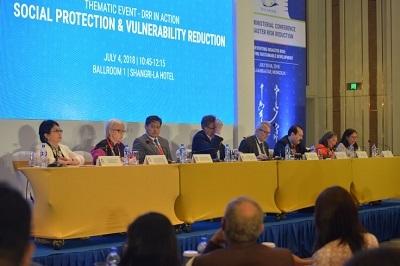
Panel discussion on social protection at the Asian Ministerial Conference on Disaster Risk Reduction
By Patrick Fuller
ULAANBATAAR, 5 July, 2018 - The role that safety nets and social protection programmes can play in reducing disaster risk features prominently on the agenda of the 2018 Asian Ministerial Conference on Disaster Risk Reduction (AMCDRR) this week.
A panel comprised of development and humanitarian actors, with senior representatives of the disaster management authorities from Mongolia and Pakistan, put forward a convincing case for greater investment in social protection policies and programmes.
“Social Protection is traditionally considered to be a development tool but it is now being used increasingly for shock response and early action. It has huge potential for building the resilience of vulnerable households and communities,” explains David Kaatrud, Regional Director for Asia Pacific with the UN World Food Programme (WFP).
“Systems like cash-based transactions provide a safety net when we see stresses on the horizon. They can also be used to help communities build back and recover in the wake of disasters”.
In Mongolia, 30% of the population are traditional nomadic herders whose livelihoods depend solely on their livestock. The country suffers a range of disasters, including the Dzud, a slow onset disaster unique to the country where summer droughts precedes a severe winter leading to a shortage of fodder for livestock.
In recent years the country’s livestock population has swelled to 66 million and 75% of rural pasture is considered to be degraded.
“The traditional response to Dzud has been mainly humanitarian, providing emergency relief and life-saving aid to herders and their animals”, explains Beate Trankmann, UN Resident Coordinator in Mongolia.
“Dzud is recurrent, they tend to hit the same populations in the northern belt of the country, making it predictable and to some extent plannable. Our focus is on working with the Government to develop better early warning mechanisms so that we can intervene before herder families reach crisis point”, she said.
The United Nations System is working with the National Emergency Management Authority of Mongolia (NEMA) in developing a monitoring system that uses 14 vulnerability indicators that can trigger early prevention measures. These indicators include precipitation levels, pasture land quality, levels of household indebtedness and sudden declines in the market price for meat.